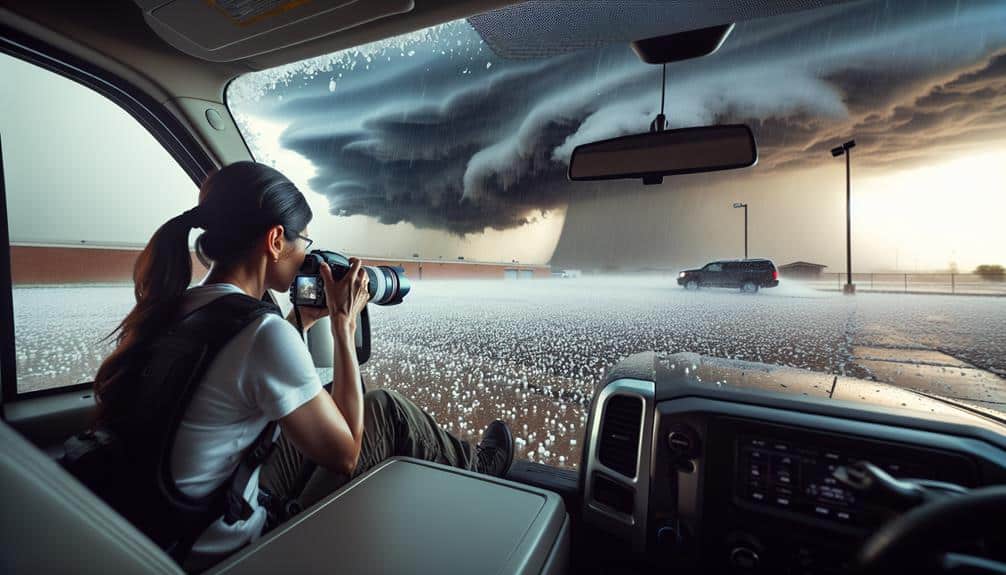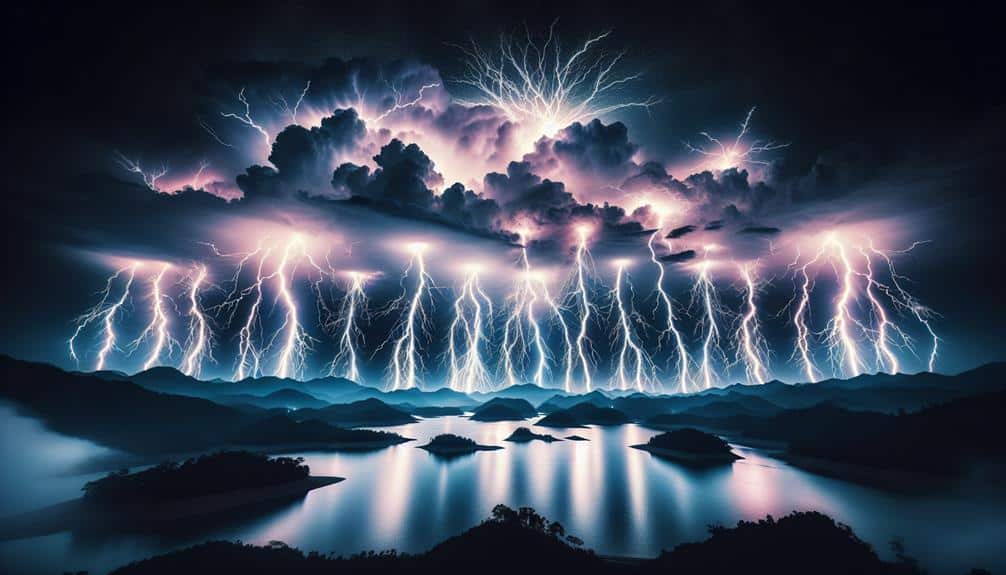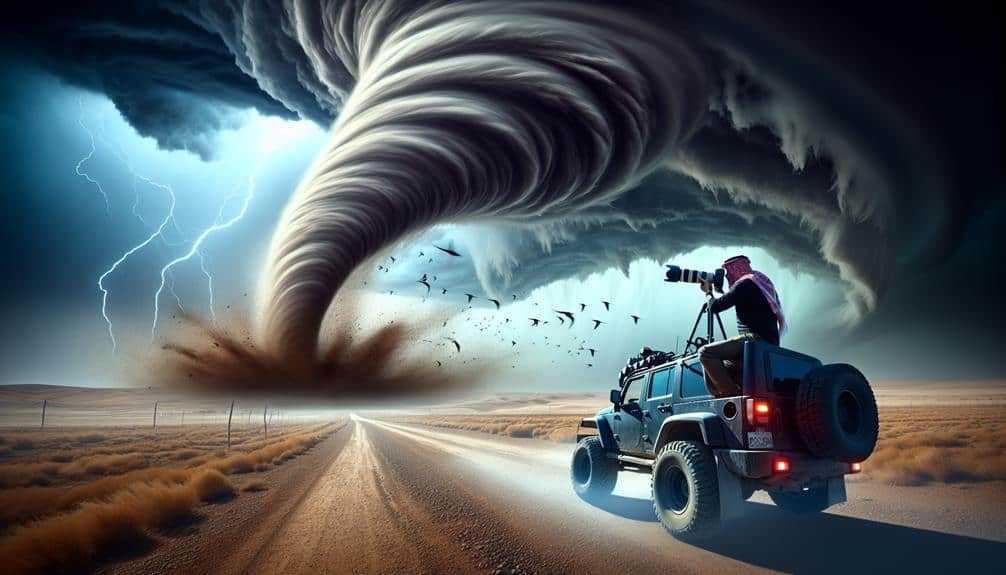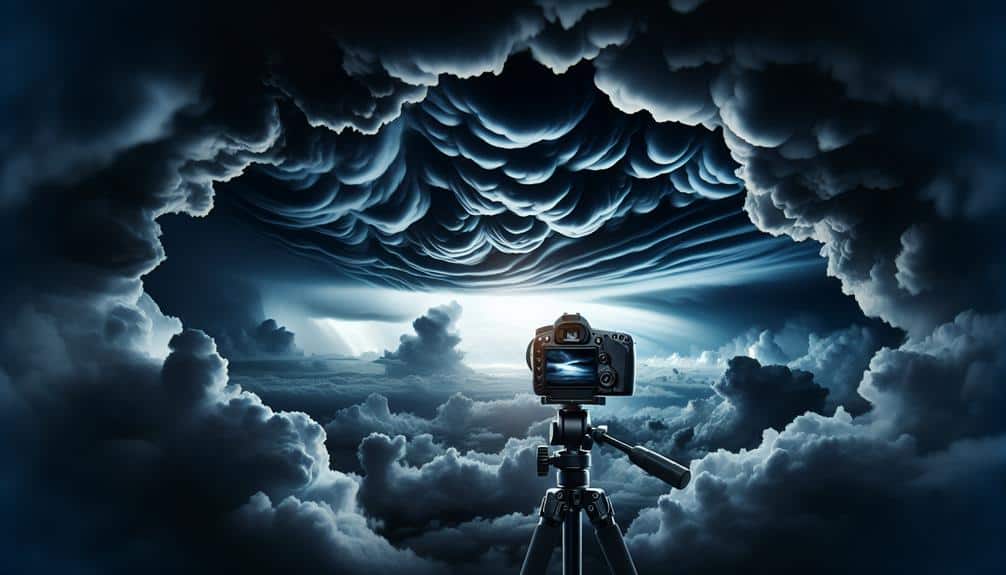We can securely capture hailstorms by selecting weather-resistant equipment, utilizing robust tripods, and employing lens protection. Analyzing meteorological data, such as temperature variations and Doppler radar, helps us forecast and get ready for storms. By locating safe vantage points with emergency shelters nearby, we minimize risks. Setting up our equipment for stability and high-speed capture guarantees we document the storm effectively. Using wide apertures and high ISO settings enhances image clarity in low light. Post-processing improves details, colors, and contrasts. Explore further to comprehend advanced weather patterns and best photographic techniques for hailstorms.
Key Points
- Use weatherproof cameras and sturdy tripods to protect equipment during hailstorms.
- Analyze meteorological data to predict storm paths and choose a safe vantage point.
- Identify emergency shelters and have protective gear ready for safety.
- Employ high-resolution satellite imagery and Doppler radar to anticipate hail events.
Choosing the Right Gear
When capturing hailstorms, selecting the appropriate gear is necessary to ensure both safety and high-quality footage. We need to focus on two main aspects: gear maintenance and equipment selection.
To start, maintaining our gear ensures it's always ready for the harsh conditions of a hailstorm. Regular checks for damage and proper storage techniques can extend the life of our equipment significantly.
In terms of equipment selection, opting for weatherproof cameras and sturdy tripods is non-negotiable. Weatherproofing is vital to protect our gear from the intense conditions we'll face. Cameras with robust seals and water-resistant housing are ideal. Additionally, lens protection, such as UV filters, can shield against unexpected impacts from hailstones.
Camera protection doesn't stop at the camera body. We must consider protective gear for ourselves as well. Helmets and padded clothing can reduce the risk of injury, allowing us to focus on capturing the event.
Analyzing data from past storm chases, we've found that using high-quality, durable equipment reduces downtime and increases footage quality. By prioritizing gear maintenance and selecting weatherproof, protective gear, we can safely and effectively document the raw power of hailstorms.
Understanding Weather Patterns
To capture hailstorms safely, we must analyze storm predictions using meteorological data and models.
Recognizing hailstorm signs, such as temperature drops and radar echoes, enhances our readiness.
This analytical approach enables us to anticipate hazardous conditions effectively.
Analyzing Storm Predictions
Effectively analyzing storm predictions hinges on understanding the intricate patterns of atmospheric behavior and leveraging advanced meteorological models. To engage in storm chasing while adhering to safety precautions, we need to decipher the complex interplay of meteorological data. This involves scrutinizing variables like temperature gradients, wind shear, and humidity levels, which collectively paint a picture of potential hailstorm activity.
By employing cutting-edge storm tracking technology, we gain real-time insights into storm development and movement. High-resolution satellite imagery, Doppler radar, and numerical weather prediction models are invaluable tools that enhance our predictive capabilities. Analyzing these data sets allows us to anticipate storm paths accurately and identify zones of severe weather risk, thereby ensuring our safety during storm chasing expeditions.
Furthermore, understanding weather patterns at a granular level enables us to interpret forecasts more effectively. For instance, recognizing the formation of supercells and mesoscale convective systems is essential. These phenomena often precede hailstorms, and their identification can be critical in planning our activities.
Recognizing Hailstorm Signs
Identifying hailstorm signs demands a keen understanding of specific atmospheric indicators such as towering cumulonimbus clouds, rapid temperature drops, and the presence of strong updrafts. When we observe these features, we're likely witnessing the precursors to a hailstorm.
Cumulonimbus clouds can reach altitudes of over 12 kilometers, creating the perfect conditions for hail formation. Rapid cooling results from these towering giants, often dropping temperatures by several degrees within minutes.
Strong updrafts play a pivotal role in hail formation. These vertical currents lift raindrops high into the freezing level of the storm, where they accumulate layers of ice. By monitoring these updrafts, we can predict hail and even estimate its size. Larger updrafts generally produce larger hailstones, as they spend more time in the storm's freezing zone.
Differentiating hail from rain requires careful observation. Hailstones, unlike raindrops, have a solid, ice-laden structure and often exhibit distinct layers upon closer inspection. By recognizing these signs, we can anticipate hail events more accurately.
This knowledge empowers us to capture the awe-inspiring moments of hailstorms safely and efficiently, ensuring that our passion for weather photography doesn't compromise our safety.
Finding a Safe Location

Selecting a safe spot for observing hailstorms entails analyzing meteorological data and geographical features to minimize exposure to hazards. By evaluating weather patterns, we can predict the storm's path and choose a vantage point that balances proximity for ideal observation with a safe distance from potential damage. Emergency shelters are essential to have nearby in case the storm intensifies unexpectedly. These shelters provide immediate refuge, ensuring our safety while we document the event.
Protective gear is another vital consideration. Helmets, padded clothing, and eye protection can prevent injuries from hailstones. We must also consider the terrain: flat, open areas offer clear visibility but leave us exposed, whereas spots with natural cover, like overhangs or buildings, provide added protection. However, these structures should be sturdy enough to withstand severe weather conditions.
Furthermore, we should avoid flood-prone areas and locations with a high density of trees, as these can become dangerous. Analyzing topographical maps and consulting local weather advisories can help us identify the safest and most efficient observation points.
Prioritizing safety doesn't mean compromising freedom; it means making informed decisions that allow us to capture the power of nature without unnecessary risk.
Setting Up Your Equipment
Properly setting up our equipment maximizes data accuracy and guarantees we capture high-quality images and measurements of the hailstorm. To begin, let's focus on camera positioning. We need to make sure our camera is angled to capture the full scope of the storm. This means choosing a vantage point that provides a clear, unobstructed view of the sky and the ground where hail impacts. Positioning our camera in this way allows us to record not just the hailstones but also their trajectory and impact behavior.
Next, let's talk about tripod stability. A stable tripod is essential when capturing a hailstorm. We should use a heavy-duty tripod that can withstand strong winds and vibrations. For added stability, we can weigh down the tripod with additional weights or sandbags. This minimizes camera shake, ensuring our footage remains clear and steady.
It's also important to secure all cables and connections. Loose cables can cause disruptions or even topple our setup in windy conditions. By carefully positioning our camera and ensuring the stability of our tripod, we can achieve the precision and reliability needed for high-quality data collection during hailstorms.
Techniques for Capturing Hail

Capturing hail requires precise timing and the use of high-speed cameras to accurately document the size, speed, and impact of each hailstone. We need to be prepared to operate our equipment quickly given the unpredictable nature of hailstorms. High-speed cameras, capable of capturing thousands of frames per second, are essential for freezing the motion of fast-falling hailstones. This allows us to analyze their trajectory and kinetic energy with scientific precision.
When storm chasing, we should prioritize our safety while positioning ourselves in prime locations to capture the most dynamic moments of the hailstorm. Utilizing radar and weather apps helps us anticipate where the hail will be most severe. Regarding weather photography, it's vital to use a sturdy tripod to keep our camera stable despite strong winds.
For the best results, we should use a lens with a wide aperture, like f/2.8 or wider, to maximize the light captured in each frame. Combining this with a high ISO setting ensures that our images remain clear even in low-light conditions commonly associated with storms.
Post-Processing Your Photos
Enhancing our hailstorm photos through post-processing allows us to bring out the intricate details and dynamic range captured during the storm. By applying various editing techniques, we can emphasize the unique textures of hailstones and the intensity of the stormy atmosphere.
To start, we should focus on enhancing colors to highlight the contrast between the dark storm clouds and the bright white hailstones. Adjusting the exposure can help in balancing the light and shadows, ensuring every detail is visible. Fine-tuning the white balance is essential to avoid any unnatural color casts that the stormy conditions might've introduced.
Here are some key steps to keep in mind:
- Adjust Exposure: Increase or decrease the exposure to reveal hidden details in the shadows or highlights.
- Enhance Colors: Use saturation and vibrancy adjustments to make the colors pop without looking oversaturated.
- Sharpen Details: Apply sharpening tools to bring out the fine details of the hailstones and storm clouds.
- Noise Reduction: Reduce noise that might've been introduced due to low light conditions.
Frequently Asked Questions
What Time of Year Is Best for Capturing Hailstorms?
We all know the perfect hailstorm waits for no one. But for the best locations and ideal equipment, aim for late spring to early summer in the central U.S. Data shows that's when Mother Nature's most dramatic displays occur.
How Can I Protect My Camera Equipment From Hail Damage?
We can protect our camera equipment from hail damage by using durable camera covers and protective cases. Data shows these measures greatly reduce impact risks, ensuring our gear stays safe while we capture nature's fury without constraints.
Are There Specific Apps for Tracking Hailstorms?
Harnessing the storm's fury, we find the best apps for tracking hailstorms include RadarScope, MyRadar, and WeatherBug. For smartphone photography tips, these apps offer real-time updates, ensuring we capture nature's chaos safely and effectively.
What Safety Measures Should I Take During a Hailstorm?
When facing a hailstorm, we should prioritize safety precautions. Stay indoors, away from windows. Implement our emergency plan, ensuring we have supplies, a safe room, and communication tools. Data shows these steps minimize injury risks.
Can I Use a Smartphone to Photograph Hailstorms Effectively?
Yes, we can use a smartphone to photograph hailstorms effectively. Modern smartphone capabilities like high-resolution sensors and advanced photography techniques enable us to capture detailed images, offering both freedom and flexibility in our meteorological documentation.


